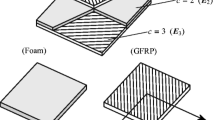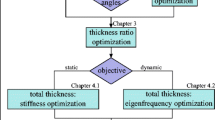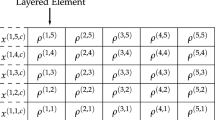Abstract
A method capable of simultaneous topology and thickness optimization of laminated composites has previously been published by one of the authors. Mass constrained compliance minimization subject to certain manufacturing constraints was solved on basis of interpolation schemes with penalization. In order to obtain large patchwise material candidate continuity while also accommodating variable laminate thickness, a bi-linear stiffness parameterization was introduced, causing a non-convex problem. In this present work, we introduce an alternative problem formulation that holds identical capabilities but is, however, convex in the original mixed binary nested form. Convexity is the foremost important property of optimization problems, and the proposed method can guarantee the global or near-global optimal solution; unlike most topology optimization methods. The material selection is limited to a distinct choice among predefined numbers of candidates. The laminate thickness is variable but the number of plies must be integer. We solve the convex mixed binary non-linear programming problem by an outer approximation cutting-plane method augmented with a few heuristics to accelerate the convergence rate. The capabilities of the method and the effect of active versus inactive manufacturing constraints are demonstrated on several numerical examples of limited size, involving at most 320 binary variables. Most examples are solved to guaranteed global optimality and may constitute benchmark examples for popular topology optimization methods and heuristics based on solving sequences of non-convex problems. The results will among others demonstrate that the difficulty of the posed problem is highly dependent upon the composition of the constitutive properties of the material candidates.





















Similar content being viewed by others
References
Ahmad S, Irons BM, Zienkiewicz OC (1970) Analysis of thick and thin shell structures by curved elements. Int J Numer Methods Eng 2:419–451
Benders JF (1962) Partitioning procedures for solving mixed-variables programming problems. Numer Math 4(1):238–252
Bendsøe MP, Sigmund O (2003) Topology Optimization - Theory, Methods and Applications. Springer Verlag, Berlin Heidelberg
Bloomfield M, Herencia JE, Weaver PM (2008) Optimization of anisotropic laminated composite plates incorporating nonconventional ply orientations. In: Proceeding of the 49th AIAA/ASME/ASCE/AHS/ASC structures, structural dynamics, and materials conference. Schaumburg, IL
Bloomfield M, Herencia J, Weaver P (2010) Analysis and benchmarking of meta-heuristic techniques for lay-up optimization. Comput Struct 88(5):272–282
Bloomfield MW, Diaconu CG, Weaver PM (2009) On feasible regions of lamination parameters for lay-up optimization of laminated composites. Proc Royal Soc A: Math, Phys Eng Sci 465(2104):1123–1143
Bonami P, Biegler LT, Conn AR, Cornuéjols G, Grossmann IE, Laird CD, Lee J, Lodi A, Margot F, Sawaya N et al (2008) An algorithmic framework for convex mixed integer nonlinear programs. Discr Opt 5(2):186–204
Bruyneel M (2010) SFP – a new parameterization based on shape functions for optimal material selection: application to conventional composite plies. Struct Multi Opt 43(1):17–27
Duran MA, Grossmann IE (1986) An outer-approximation algorithm for a class of mixed-integer nonlinear programs. Math Programm 36(3):307–339
Duysinx P, Guillermos M, Gao T, Bruyneel M (2013) Comparison of parameterization schemes for solving the discrete material optimization problem of composite structures. In: Proceedings of 10th World Congress of Structural and Multidisciplinary Optimization (WCSMO), Florida, USA
Fletcher R, Leyffer S (1994) Solving mixed integer nonlinear programs by outer approximation. Mathematical Programming 66(1-3):327–349
Floudas CA (1995) Nonlinear and Mixed-Integer Optimization: Fundamentals and Applications (Topics in Chemical Engineering). Oxford University Press, New York
Floudas CA, Gounaris CE (2009) A review of recent advances in global optimization. J Global Opt 45(1):3–38
Floudas CA, Pardalos PM (2009) Encyclopedia of optimization, 2nd. Springer
Gao T, Zhang W, Duysinx P (2012) A bi-value coding parameterization scheme for the discrete optimal orientation design of the composite laminate. Int J Numer Methods Eng 91(1):98–114. doi:10.1002/nme.4270
Geoffrion AM (1972) Generalized benders decomposition. J Opt Theory Appl 10(4):237–260
Ghiasi H, Pasini D, Lessard L (2009) Optimum stacking sequence design of composite materials Part I: Constant stiffness design. Composit Struct 90(1):1–11
Ghiasi H, Kazem F, Pasini D, Lessard L (2010) Optimum stacking sequence design of composite materials Part II: Variable stiffness design. Composit Struct 93(1):1–13
Gill PE, Murray W, Saunders MA (2005) SNOPT: An SQP algorithm for large-scale constrained optimization. SIAM Review 47(1):99–131
Grenestedt JL, Gudmundson P (1993) Layup optimisation of composite material structures. In: Proceedings of the IUTAM Symposium on Optimal Design with Advanced Materials. Amsterdam, The Netherlands, pp 311–336
Grossmann IE (2002) Review of nonlinear mixed-integer and disjunctive programming techniques. Opt Eng 3(3):227–252
Hansel W, Treptow A, Becker W, Freisleben B (2002) A heuristic and a genetic topology optimization algorithm for weight-minimal laminate structures. Composit Struct 58(2):287–294
Weaver P, Friswell M (2008) Optimization of anisotropic composite panels with T-shaped stiffeners including transverse shear effects and out-of-plane loading. Struct Multi Opti 37(2):165–184
Hvejsel CF (2011) Multi-Material Design Optimization of Composite Structures. Ph.D. thesis, Department of Mechanical and Manufacturing Engineering, Aalborg University, Denmark, special report no. 73
Hvejsel CF, Lund E (2011) Material interpolation schemes for unified topology and multi-material optimization. Struct Multi Opt 43(6):811–825
Hvejsel CF, Lund E, Stolpe M (2011) Optimization strategies for discrete multi-material stiffness optimization. Struct Multi Opt 44(2):149–163
IBM ILOG (2011) IBM ILOG CPLEX Optimization Studio V12.4. http://www.ibm.com
Kennedy GJ, Martins JRRA (2013) A laminate parametrization technique for discrete ply-angle problems with manufacturing constraints. Structural and Multidisciplinary Optimization doi:10.1007/s00158-013-0906-9
Le Riche R, Haftka RT (1995) Improved genetic algorithm for minimum thickness composite laminate design. Composit Eng 5(2):143–161
Le Riche R, Haftka RT (2012) On global optimization articles in SMO. Struct Multi Opt 46(5):627–629
Leyffer S (2001) Integrating SQP and branch-and-bound for mixed integer nonlinear programming. Comput Opt Appl 18(3):295–309
Leyffer S, Linderoth J, Luedtke J, Miller A, Munson T (2009) Applications and algorithms for mixed integer nonlinear programming. J Phys: Conf Series 180(1):012–014
Liu BT, Haftka RA, Akgün M, Todoroki A (2000) Permutation genetic algorithm for stacking sequence design of composite laminates. Comput Methods Appl Mech Eng 186(2):357–372
Liu D, Toropov V, Querin O, Barton D (2011) Bilevel optimization of blended composite wing panels. J Aircr 48(1):107–118
Lund E, Stegmann J (2005) On structural optimization of composite shell structures using a discrete constitutive parametrization. Wind Energy 8(1):109–124
Magnanti TL, Wong RT (1981) Accelerating Benders decomposition: Algorithmic enhancement and model selection criteria. Oper Res 29(3):464–484
Muñoz E, Stolpe M (2011) Generalized Benders’ Decomposition for topology optimization problems. J Global Opt 51(1):149–183
Muñoz E (2010) Global Optimization for Structural Design by Generalized Benders? Decomposition. Ph.D. thesis, Department of Mathematics, Technical University of Denmark
Panda S, Natarajan R (1981) Analysis of laminated composite shell structures by finite element method. Comput Struct 14(3-4):225–230
Sigmund O (2011) On the usefulness of non-gradient approaches in topology optimization. Struct Multi Opt 43(5):589–596
Sørensen SN, Lund E (2013) Topology and thickness optimization of laminated composites including manufacturing constraints. Structural and Multidiciplinary Optimization doi:10.1007/s00158-013-0904-y
Stegmann J, Lund E (2005) Discrete material optimization of general composite shell structures. Int J Numer Methods Eng 62(14):2009–2027
Stegmann J, Stolpe M (2006) Discrete material optimization of laminated composites - SIMP vs. global optimization. In: III European Conference on Computational Mechanics, Springer, pp 732–732
Still C, Westerlund T (2006) Solving convex minlp optimization problems using a sequential cutting plane algorithm. Comput Opt Appl 34(1):63–83
Stolpe M, Stegmann J (2008) A Newton method for solving continuous multiple material minimum compliance problems. Struct Multi Opt 35(2):93–106
Svanberg K (1994) On the convexity and concavity of compliances. Struct Opt 7(1–2):42–46
Toropov VV, Jones R, Willment T, Funnell M (2005) Weight and Manufacturability Optimization of Composite Aircraft Components Based on a Genetic Algorithm. In: Proceedings of 6thWorld Congress of Structural and Multidisciplinary Optimization (WCSMO), Rio de Janeiro, Brazil
Tsai SW, Pagano NJ (1968) Invariant properties of composite materials. In: SW Tsai et al (ed) Composite Materials Workshop, Technomic Publishing Co., Stamfort, Connecticut, Progress in Material Science, vol 1, pp 233–253
Westerlund T, Pettersson F (1995) An extended cutting plane method for solving convex MINLP problems. Comput Chem Eng 19:131–136
Acknowledgements
This work was supported by the Danish Centre for Composite Structures and Materials for Wind Turbines (DCCSM), grant no. 09-067212 from the Danish Strategic Research Council. This support is gratefully acknowledged.
Author information
Authors and Affiliations
Corresponding author
Rights and permissions
About this article
Cite this article
Sørensen, S.N., Stolpe, M. Global blending optimization of laminated composites with discrete material candidate selection and thickness variation. Struct Multidisc Optim 52, 137–155 (2015). https://doi.org/10.1007/s00158-015-1225-0
Received:
Revised:
Accepted:
Published:
Issue Date:
DOI: https://doi.org/10.1007/s00158-015-1225-0




